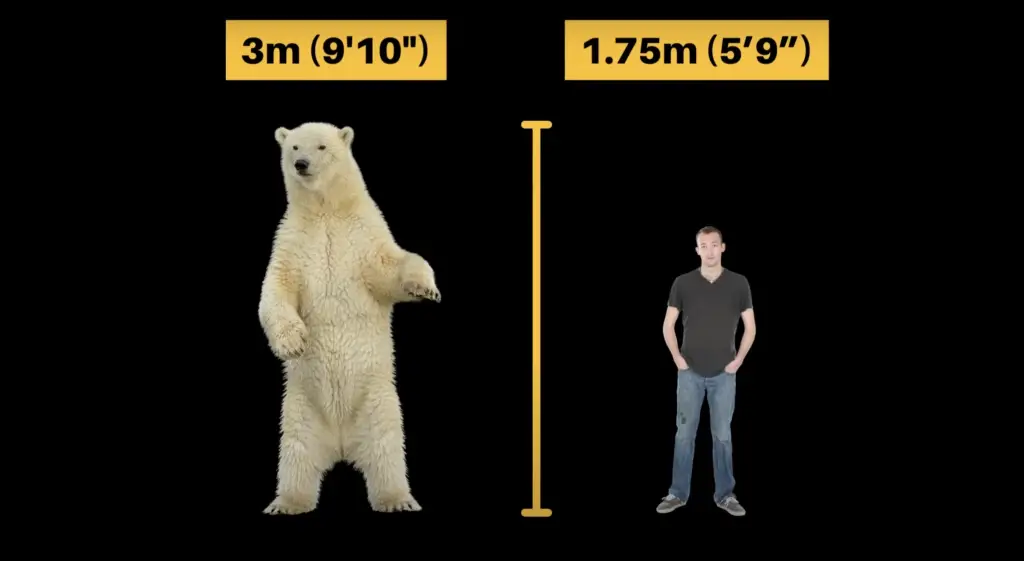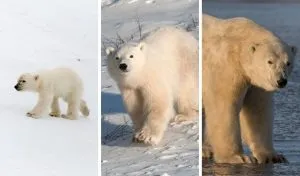Given their confines to the arctic, most of us have only read facts about polar bears and seen them in photos, so it can be hard to judge their size in real life. But, just how big are polar bears?
Polar bears are the biggest bear species. An adult male is between 2.4-3m (8-10 feet) in size and weighs between 350-680kg (775-1500lbs). Females are slightly smaller at around 1.8-2.4m (6-8 feet) and weighing between 150-250kg (330-550lbs).
Keep reading for more facts about the size of polar bears and how they compare to other animals.
How Big is a Polar Bear?
When measuring the size of polar bears (and other mammals), scientists measure the length from their nose to the tip of their tailbone.
An average male polar bear is 2.4-3m (8-10 feet) in size whereas a female is smaller at 1.8-2.4m (6-8 feet), on average1 (source: The Polar Bear, A. Hemstock, 1999). Standing next to an adult male polar bear is said to be like standing next to a large pony.
It is thought that male polar bears are bigger than females because they reach sexual maturity later, this is usually around age 6 for males compared to age 5 for females2 (source: Polar Biology, A. Rosing-Asvid, E. W. Born and M. C. S. Kingsley, Vol 25, 2002).
Polar bears are considered to be the largest bear species, more later on how their size compares to other bears.
When on all fours, the height of a polar bear is 1.3 – 1.6m (4’4” – 5’3”). They can also stand up on their hind legs which can make them up to 3m (10 feet) tall.
How Big is a Baby Polar Bear?
A baby polar bear is about 30cm (12 inches) long when it is first born3 (source: The Polar Bear, A. Hemstock, 1999).
Pregnant female polar bears will create maternity dens where they will enter a hibernation-like state for 8 months during which time they will not eat, drink, urinate, or defecate4 (source: Polar Bears: A Complete Guide to Their Biology and Behavior, A. E. Derocher, 2012).
The cubs are born in December/January. The mother will remain in the den with the mother for the first few months. They grow very quickly and are able to begin walking at two months old.
How Much Do Polar Bears Weigh?
Curious how heavy polar bears are? Well you’re in the right place. Adult male polar bears weigh between 350-680kg (775-1500lbs) and females weigh between 150-250kg (330-550lbs)5 (source: The Polar Bear, A. Hemstock, 1999).
The weight of a polar bear may vary widely throughout the year, carrying around 50% extra weight as fat. This fat is mainly concentrated around the base of their back and butt with little fat on their legs, neck, or head6 (source: Polar Bears: A Complete Guide to Their Biology and Behavior, A. E. Derocher, 2012).
The fat beneath their skin can form in layers up to 10cm (4 inches) thick7 (source: Polar Bears, K. Allen, 2013). They can maintain so much weight due to their specialized diet which mostly consists of ringed and bearded seals.
Seal blubber is high in energy so a 500kg polar bear would only need to eat 1 kg of seal blubber per day to maintain its body mass which is easily achievable for most8 (source: Journal of Mammalogy, M. G. Dyck and E. Kebreab, Vol 90, Issue 3, 2009).
However, they must also build up excess fat during winter which they can then convert into energy during summer when they are not able to hunt seals.
How Much Do Baby Polar Bears Weigh?
Baby polar bears (cubs) weigh 454-680g when they are born9 (source: The Polar Bear, A. Hemstock, 1999).
They will remain in the maternity den where they are born for the first few months of their lives until they weigh around 10kg and have learned to walk10 (source: Arctic Animals and Their Adaptations to Life on the Edge, A. S. Blix, 2005).
However, there is a lot of variety in the weight of baby polar bears as they leave the den, from as low as 3kg (6.6lbs) up to 24.5kg (54 lbs).
The more subs a female polar bear has, the smaller the cubs will be. Single cubs weigh the most, followed by twins, and finally triplets. In triplets, there is often one tiny cub that usually will not survive11 (source: Polar Bears: A Complete Guide to Their Biology and Behavior, A. E. Derocher, 2012).
Polar Bear Size Comparison: Size of Polar Bears vs Other Bears
Let’s take a look at how polar bears compare to other bear species such as grizzly, Kodiak, and black bears.
Polar Bear Size vs Grizzly Bear
On average, polar bears are bigger than brown bears. The main sub-population of brown bear found in North America, the grizzly bear, will typically weigh between 150-350kg (adult male)12 (source: Brown bear, S. Eide, S. D. Miller, and H. V. Reynolds, 1994). This is smaller than an adult male polar bear which weighs 350-680kg (775-1500lbs) on average.
Polar Bear Size vs Kodiak Bear
The Kodiak bear is another sub-population of brown bears, found in coastal Alaska and Kodiak Island.
These bears weigh around 357kg so can rival some of the smaller polar bears in weight13 (source: Brown bear, S. Eide, S. D. Miller, and H. V. Reynolds, 1994). However, on average, a polar bear is still bigger.
According to the Guinness World Records, a Kodiak bear is usually shorter in length than a polar bear but more robustly built.
Polar Bear Size vs Black bear
An average male American black bear is smaller than a polar bear with a weight between 59 – 300 kg compared to a male polar bear which will usually weigh 350-680kg (775-1500lbs) on average.
Polar Bear Size Comparison: How Big is a Polar Bear Compared to Humans?
A male polar bear is about 1.5 times taller than a male human and more than 5 times heavier.
The average male polar bear is between 2.4-3m (8-10 feet) in length and weighs 350-680kg (775-1500lbs). Whereas an adult male human (from the USA) is 1.75m (5’9”) tall14 (source: Healthline) and weighs 90kg (198lbs)15 (source: Healthline).

Related Questions
How Big Do Polar Bears Get? What is the Largest Polar Bear Ever Recorded?
According to The Guinness Book of Animal Records, the largest polar bear ever recorded was a 998 kg (2,200-pound) bear shot in Kotzebue Sound, Alaska in 1960.
When stood on its hind legs, the polar bear would have been a whopping 3.39 m (11 ft 1 in) tall.
How Strong is a Polar Bear?
Polar bears do not have any natural predators in the Arctic where they live, this is in part due to their sheer size and strength that allows them to dominate the food chain.
They are strong enough to take on seals, walrus, and even whales which all form a part of their primary diet of marine mammals.
How Fast is a Polar Bear?
Despite their size, polar bears can run fast when they want to. A polar bear can sprint at speeds up to 40 km/h (25 mph) over short distances.
However, it takes a lot of energy to move this fast so they can easily overheat. You will usually find them moving at a slower pace of around 5.5 km/h (3.4 mph)16 (source: Seaworld).




![Read more about the article 42 Polar Bear Jokes [Sure to Break the Ice]](https://polarguidebook.com/wp-content/uploads/2021/09/Polar-bear-jokes-300x176.jpg)
![Read more about the article How Fast Are Polar Bears on Land and Underwater? [Surprisingly Quick!]](https://polarguidebook.com/wp-content/uploads/2021/08/How-Fast-are-Polar-Bears-300x176.jpg)